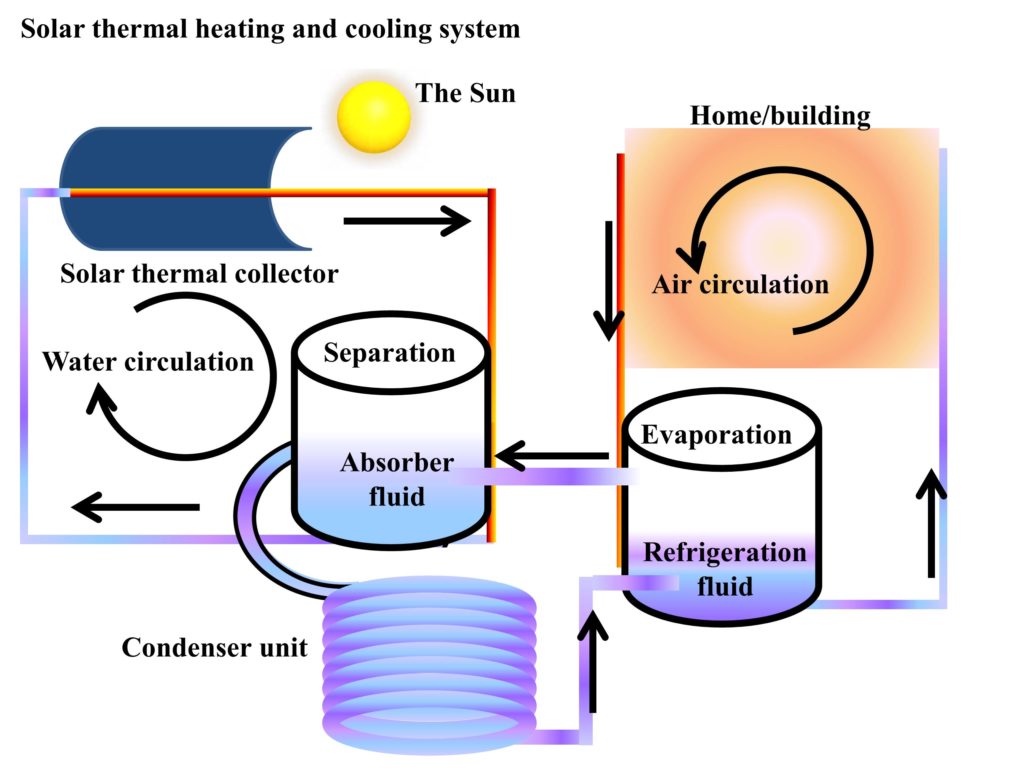Solar thermal Energy Collection
The two major solar energy extraction mechanisms are the photovoltaic effect (which converts solar energy to electrical energy through solar cells, discussed previously in the Renewable Energy section) and solar thermal energy collection. The energy extraction through the solar thermal collector utilizes the heat energy in sunlight to heat a working fluid, which then evaporates to run the turbine. This working fluid is then condensed back to its original state and sent back to the evaporation chamber. This process continues indefinitely to generate electrical power till solar energy is available. Generating electrical power from solar thermal energy has the following advantages (highlighted in green) and disadvantages (highlighted in red) over photovoltaic (PV) technology.
Advantages
- Clean and renewable,
- Gives more efficiency for particular applications (especially direct cooling and heating systems),
- Low area requirements, and
- Less costly than PV systems when the initial investment is considered.
- Have lower scalability than PV cells (PV cells have more options in terms of sizes and voltage).
Disadvantages
- Generating energy involves moving parts, which reduces efficiency,
- Have lower life than PV system,
- Lower efficiency in winters as the temperature is low in winters, whereas PV panels usually work more efficiently in winters due to reduced cell temperature, and
- Carry larger operational costs.
Since, we are concentrating on solar thermal energy, let’s discuss an application for which solar thermal energy is most suitable i.e., solar thermal heating and cooling systems.
Solar thermal energy heating and cooling system
In solar thermal heating and cooling systems, the heat obtained from solar thermal collectors is directly employed for heating and cooling purposes. Therefore, higher efficiency can be obtained from such systems. These systems are not made for electricity generation and usually do not involve any moving parts. Solar thermal heating and cooling systems work on the principle of evaporation, which causes a cooling effect. Evaporation is a phenomenon in which high-energy molecules leave the surface of a fluid, which lowers the temperature of the fluid, thus causing a cooling effect. This is the same as evaporation of sweat lowers the temperature of the body surface.
The heating and cooling from solar thermal system employs following steps.
Evaporation Chamber
The warm air from house/building or just a room is carried to an evaporation chamber, where there is a mixture of absorber and refrigeration fluids. The absorber fluid and refrigeration fluids get warmed up and refrigeration fluid evaporates due to lower boiling point, cooling absorbing fluid left behind.
Separation chamber
The evaporated refrigeration fluid reaches separation chamber, where a mixture of absorber and refrigeration fluids are heated till the refrigeration fluid is separated from absorber fluid and is condensed through condenser unit. The heating in this unit is done through the heated water from solar thermal energy collectors.
Solar thermal energy collectors
Solar thermal energy collectors are equivalent to PV panels, where solar thermal collectors collect solar energy in the shape of heat and transfer this energy to absorber fluid. This fluid absorbs the thermal energy and evaporates a system of absorber and refrigerant fluid. In Fig. 1, a parabolic mirror is shown which reflects the solar energy to a receiver which is present as a hot cylinder in front of the parabolic mirror. These mirrors have sun tracking enabled, which means they move as the sun changes its position in the day. This movement enables the mirrors to capture the most sunlight at any instant of the day.
Condenser unit
This unit condenses the refrigeration fluid and converts it back into liquid phase from vapor phase. This condensed refrigeration fluid is transferred to evaporation chamber, where it cools the warm air from the house/building.
A diagram depicting these components of solar thermal energy heating and cooling system is presented in Fig. 1.

